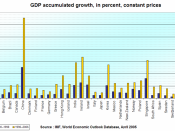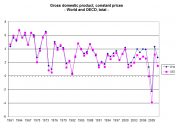The GDP stands for Gross Domestic Product and is the mostly closely watched economic statistic. It is composed of the market value of all final goods and services produced within a country in a given period of time. It includes all items produced in the economy and sold legally in markets. The GDP is related to productivity. Productivity is made up of technology, skills, natural resources, and physical capital. Other things that the GDP is related to include consumption, investment, government purchases, and net exports. In this paper, we will take these things into consideration for the countries of Ireland and Bolivia.
As of the year 2004, Ireland (the developed country we picked) ranked 30th out of 184 countries with a GDP of $183,560,000,000. The 2004 GDP per capita was estimated at $29,800. The average GDP annual growth rate since 1995 for Ireland has been 8.1%. The next closest country is the United States, with an average growth rate of 3.3%
per year since 1995. There are a few things to consider before analyzing IrelandÃÂs GDP. Ireland is a modern but small country that depends on trade in their economy. Over the past 10 years, IrelandÃÂs government has put in programs to curb inflation, promote foreign investment, and cut back on their own government spending. As a result, the economy grew 9% in between 1995-2000. These efficient economic moves are a big reason that Ireland is one of the top countries in the world in terms of GDP.
IrelandÃÂs productivity is very high. Ireland has recently had a big improvement in technology, the first aspect of productivity. IrelandÃÂs favorable corporate tax structure and broadband access to the internet for ordinary citizens is a result of the new technology. A program named Enterprise Ireland was developed to better the technology in...

![[Irish spinner and spinning wheel. County Galway, Ireland] (LOC)](https://s.writework.com/uploads/7/75615/irish-spinner-and-spinning-wheel-county-galway-ireland-loc-thumb.jpg)
